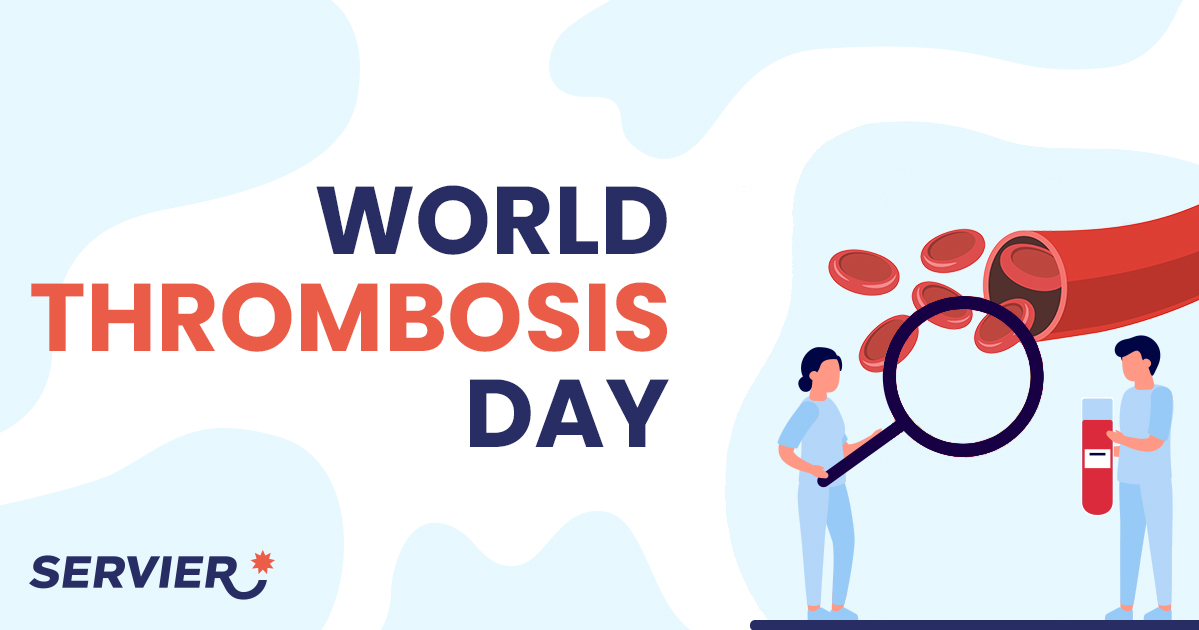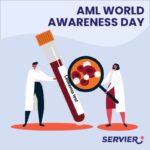
At Servier Canada, we pride ourselves on our involvement in cardiovascular medicine. Committed to the health and well-being of patients, we strive to find innovative therapeutic solutions for all. As such, Servier Canada believes in the importance of lending its support to awareness campaigns that aim to highlight vascular conditions, such as thrombosis.
World Thrombosis Day (WTD) is held every year on October 13th to raise international awareness about thrombosis. This serious medical condition, which is often overlooked and misunderstood, involves blood clots that can cause heart attacks, strokes and venous thromboembolism. Celebrating its 10th anniversary this year, the campaign seeks to increase awareness of this largely preventable condition while aiming to reduce the number of undiagnosed cases and prevent life-threatening complications.
Thrombosis – An Overview
Thrombosis is the formation of a blood clot in a blood vessel. The vessel may be any vein or artery, as, for example, in a deep vein thrombosis (venous) or a coronary artery (arterial). The clot itself is termed “thrombus”. Once formed, a clot can slow or block normal blood flow, and even break loose and travel to an organ. A clot that travels to the circulation is called an embolism. Thrombosis is the often-preventable underlying pathology of heart attack, thromboembolic stroke and venous thromboembolism (VTE), the top three cardiovascular killers.

Thrombosis-Related Conditions
Atrial Fibrillation
Atrial fibrillation, or AFib, is a common type of irregular heart rhythm (arrhythmia). Arrhythmias are due to electrical signal disturbances of the heart. AFib affects the top two chambers of the heart (the atria), although arrhythmias can also occur in the two chambers below the atria (the ventricles) and tend to be more serious than those affecting the atria. In a healthy person, regular electrical signals help push blood efficiently from the atria into the ventricles, and from there, blood is pumped to the rest of the body. In AFib, the electrical signals are fast, irregular and disorganized, and the heart may not pump as efficiently. Because the heart beats and contracts irregularly, blood flow in the atria is reduced and can cause the formation of a clot. A blood clot that forms as a result of AFib and breaks free is an example of arterial thromboembolism. If that clot breaks free, it can lodge in an artery, most commonly travelling to the brain and resulting in a stroke. The clot can also travel to other places such as legs or arms.
Deep Vein Thrombosis
Deep vein thrombosis (DVT) is a blood clot that forms in the deep veins of the body. Blood clots occur if there are changes to blood flow, changes that make the blood more coagulated or when there is damage to the blood vessel wall, such as with surgery. Most deep vein blood clots occur in the lower leg or thigh, but they can also occur in other parts of the body, such as the arms, neck, brain or abdomen. A blood clot in a deep vein can break off and travel through the bloodstream. The loose clot can travel to an artery in the lungs and block blood flow in the lungs, which can put pressure on the heart. This condition is called pulmonary embolism and can be very serious.
Pulmonary Embolism
Pulmonary embolism (PE) is a blockage in a lung artery. This blockage is usually caused by a blood clot that travels to the lung from a vein in the leg, also known as deep vein thrombosis. A clot that forms in one part of the body and travels in the bloodstream to another part of the body is called an embolus. PE is a serious condition that can:
• Damage part of your lung because of a lack of blood flow to your lung tissue. This damage may lead to pulmonary hypertension (increased pressure in the pulmonary arteries).
• Cause low oxygen levels in your blood.
• Damage other organs in your body because of a lack of oxygen.
Cancer-Associated Thrombosis
Venous thromboembolism (VTE) is a common complication in patients diagnosed with cancer. The risk of blood clots is driven and modified by risk factors such as surgery, hospitalization, infection and genetic coagulation disorders, as well as certain cancer-specific factors.
Signs and Symptoms
Knowing the most common blood clot signs and symptoms can help you identify and even prevent this potentially life-threatening condition. If you feel a sign or symptom, contact a healthcare provider immediately.
Deep Vein Thrombosis
• Pain or tenderness, which often starts
in the calf.
• Swelling of the leg, including the ankle
or foot, which can occur in a minority
of cases. For upper extremity blood clots, the pain is usually in the arm or shoulder region. Swelling can also occur in upper extremity DVTs.
• Discolouration
• Redness or noticeable
discolouration in the leg or arm
Pulmonary Embolism
• Pulmonary Embolism
• Rapid breathing or difficulty
catching your breath
• Chest pain that becomes
worse with deep breaths
• Light-headedness or passing out
• Coughing up blood

World Thrombosis Day: A Campaign to Move Against Thrombosis
Servier Canada is proud to take part in World Thrombosis Day; join us in moving forward to advocate for awareness, education and action for thrombosis-related conditions. If you would like to know more about the ways World Thrombosis Day will be highlighted in Canada, head to Thrombosis Canada’s website, where you will also find a wealth of materials, videos and tools. Support this important cause, get moving and spread the word!




